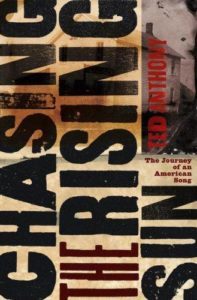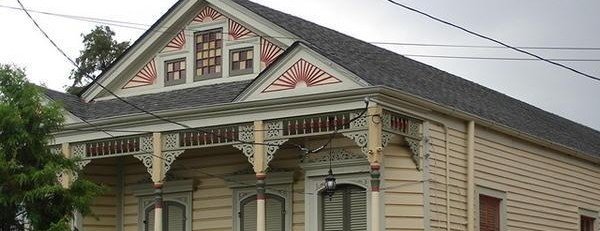
Today, we’re bringing you another entry in American Blues Scene’s exclusive “Brief History of a Song” series.
To most people, even mentioning House of the Rising Sun evokes memories of The Animals‘ 1964 smash hit, with it’s instantly recognizable circular chord pattern in A-minor. The song itself, however, enjoys a hidden and shockingly broad history that spans every folk-inspired corner of the United States, and dates far earlier than the mid-1960s, when it’s popularity exploded.
Like so many folk songs, the House of the Rising Sun‘s true “origins,” along with exactly where — or even what the Rising Sun was have been washed away by time. The often disputed birth of the song’s existence on record, as so many other countless folk songs, began with Alan Lomax, who recorded a young girl named Georgia Turner singing the song Acappella in the Appalachian hills of rural Kentucky. Georgia was merely 16 when she recorded the song, but was largely mum on where she had learned it. Lomax included the song in the popular Library of Congress album Our Singing Country in 1941.
Notable folk singer Clarence Ashley actually did make an earlier recording of the same song in 1933, where his version is definitively in the bluegrass style. Clarence had said that he learned the song from his grandfather, meaning the song’s origins can be dated to considerably older than 1933. What is interesting is that, while both Ashley and Turner come from the Appalachia region, Clarence was from Tennessee and Georgia was from Kentucky. The two were over 100 miles apart, a considerable distance in the 1930s, yet both sang eerily similar versions of the song. In an age where few could afford record players or radios, how did so many people learn the same music such as the Rising Sun? And in an era before cars were common and highways were still 25 years away, how did songs like this one manage to spread across the country? Several have researched the topic of “floating songs”, which, much like the songs themselves, has murky and hard-to-trace origins.
Ted Anthony wrote a definitive book on Rising Sun called Chasing the Rising Sun. In it, his journey in search of the true birth of the song take him to a dozen states and even across the Atlantic ocean. The book expertly discusses Rising Sun as a part of the greater story of the spread of folk music at large. Anthony presents several ways songs tended to move across the confining borders of small towns where many of the folk singers, both recorded or otherwise, lived their entire lives and died. Anthony asserts that Clarence Ashley actually traveled the Appalachia area in the 1920s with medicine shows. Medicine shows, popular in the early-to-mid 1900s, were traveling bands of musicians and salesmen. In a new town, the musicians would sing songs to entertain and draw crowds, and the salesmen would take advantage of the gathering to sell bottled “medicine”, (which could often better be described as flavored alcohol!) It was these early traveling shows that helped untold numbers of folk songs spread. Clarence, as well as unknown others, may have sang the famous House to numerous towns in Appalachia, where some townsfolk would remember and re-sing the song time and again, improvising if they forgot a word or phrase.
Early folk songs such as Rising Sun were also spread through the railroads. These were times when the only practical means of travel across long distances, which sometimes even meant 100 miles or less, was by train. It was also a time when train lines were still largely being built across America, with many workers singing in unison as they laid rail lines into and from various towns. This can be evidenced in many of both Alan Lomax and his father, John’s folk recordings, where dozens of workers can be found singing in unison — and sometimes harmony — to the tune of their hammers hitting railroad spikes. Anthony describes a situation where he found a version of House of the Rising Sun, in Oklahoma. Though the “house” was not the called the Rising Sun but another, more localized infamous establishment, and the lyrics were changed slightly, the song was nonetheless obviously of the school of the “original”. It was likely the railroads, theorizes Anthony, that would enable some anonymous soul to carry the song from the mountains in the east all the way to the plains in the midwest.
As records became more popular, so did recordings of the House of the Rising Sun. Instead of chance hearing-and-remembering by hand fulls of troubadours, records were common and fairly easy to come by. From the 1940s on, many artists recorded various versions of the song, occasionally under different titles, but generally the same lyrics and chord progressions. Leadbelly released several versions of the song in the 1940s. in 1958, Pete Seeger recorded a version on the banjo and, as was often common in earlier versions of the song, he sang it from the perspective of a woman. Woodie Guthrie recorded a version, as did both Joan Baez and Bob Dylan, who had arguably the most famous version until the Animals’ cover several years later. The Animals recorded their world-famous version in one take during a May, 1964 recording session. It became an immediate hit, and topped both the U.S. and U.K. single charts that year. The song has been continuously been lauded for it’s sound and staying power, and remained The Animals most popular single.
As for the location of the actual house of the Rising Sun, it likely never existed in reality — despite the often-repeated instructions from French Quarter tour operators and passively amused, often conflicting directions from many locals and well-meaning tourists alike. As Nola.com, a division of the Times-Picayune, reported in 2007, if a fabled Rising Sun ever did exist in New Orleans, currently the most likely location to claim the honor is located on 535-537 Conti St. in the famous French Quarter, where evidence of a hotel named Rising Sun was found. Excavators discovered unusual amounts of makeup containers and liquor bottles, and a newspaper ad stating that the hotel was open to “discerning gentlemen”, which could have possibly alluded to prostitution. Rising Sun is thought to have operated from 1808-1822, when it burned. The site is now a gallery for the Historic New Orleans Collection museum. Realistically, though, according to archaeologist Shannon Dawdy, who uncovered most of the artifacts, the hotel could just as easily have been a hotel for men, which was not uncommon. It was also not uncommon for men of that era to apply some makeup to themselves, thus the evidence is not sufficient enough to be definitive by any means.
There have been tales of a picture of a women’s prison outside of New Orleans with a stone etching of a rising sun over the gate, though no images have surfaced to date. The theory is plausible, since most versions before the 60s made the narrator a woman, and many renditions include the phrase “ball and chain”. A house on Esplanade Ave, just beside the French Quarter in the Treme neighborhood has, at times, been referenced as being “the” Rising Sun, as have several other places in the area. In all actuality, the term “Rising Sun” was and continues to be (no doubt fueled, in part, by the song’s staying power and popularity, bringing it full-circle,) a common phrase. Different, interchanged versions of the song from across the country have been known to substitute New Orleans for another town, and the Rising Sun for a different establishment, aiding in muddying even the city and state, let alone exact street or building. Often times the establishment is a brothel, or a gambling parlor, bar, or prison. Many of the earlier singers likely never visited New Orleans, certainly 16 year old Georgia Turner did not, and the house of the Rising Sun could just as easily be a alliteration which means any generic place of ill repute. In truth, it will likely never be definitively known.
There has been evidence to suggest that the song, though it’s origins are commonly traced back as far as the early 1900s Appalachia area, has strong roots dozens or even hundreds of years earlier in England. As many people over the years churned and moved and settled, the places that components of the song could have come from are nearly endless. Much like hundreds of other folk songs, the epicenter of House of the Rising Sun is lost to the past. It was a song that was passed from person to person and from one generation to the next. It’s earliest singers, the location of the house that so many had apparently spent their lives in sin and misery, and most everything else about the song is a mystery. Perhaps this mystery, along with the somewhat anonymous lyrics and spooky minor chords, is part of what has continued to intrigue so many thousands and millions over the years.
Chasing the Rising Sun by Ted Anthony on Amazon
Our Singing Country: Folk Songs and Ballads
Alan Lomax, Dover Publications, 1941
THE RISING SUN BLUES
e. No. 1404. Georgia Turner, Middlesboro, Ky., 1937-Other stanzas, Bert Morton, Manchester, Ky., No. 1496.There is a house in New Orleans they call the Rising Sun,
It’s been the ruin of many poor girl, and me, O God, for one.If I had listened what mama said, I’d’a’ bee at home today,
being so young and foolish, poor boy, let a rambler lead me astray.Go tell my baby sister never to do like I have done,
To shun that house in New Orleans they call the Rising Sun.My mother she’s a tailor, she sold those new blue jeans,
My sweetheart, he’s a drunkard, Lord, Lord, drinks down in New Orleans.The only thing a drunkard needs is a suitcase and a trunk.
The only time he’s satisfied is when he’s on a drunkFills his glasses to the brim, passes them around.
The only pleasure he gets out of life is hoboin’ from town to town.One foot is on the platform and the other on on the train,
I’m going back to New Orleans to wear that ball and chain.Going back to New Orleans, my race is almost run,
Going back to spend the rest of my life beneath that Rising Sun



8 Comments
Well written article. I believe you could use the same premise to talk about many songs that have been popular throughout recent time. Several early blues songs were culled from the call and response singing of the slaves, which were then culled themselves for many popular rock songs in the sixties. Early Creme, Led Zepplin, Jeff Beck, Beatles, and so many more used bits and pieces of blues classics (and sometimes whole songs) as filler songs and even hits on their early work. Eric Clapton continues to release blues classics and has made an incredible impact by stressing the importance of the blues on current popular music. Great job!
Informative piece. One little correction: Clarence Ashley did not play “bluegrass,” but “old time,” which is a precursor of bluegrass. Bluegrass is a more modern form of country music that was invented by Bill Monroe and his band in the 1940s. It is a common misconception.
This is a nice summary of factoids. The essence of opinion seems to me to be at least appropriate if not more than so. To recount history in a way that many could relate to is a gift. Matt is one of the gifted ones. Thanks for putting your heart into what you say and to not go “beyond the things written”. Nice work!!
You should write for the rolling stone man!!!